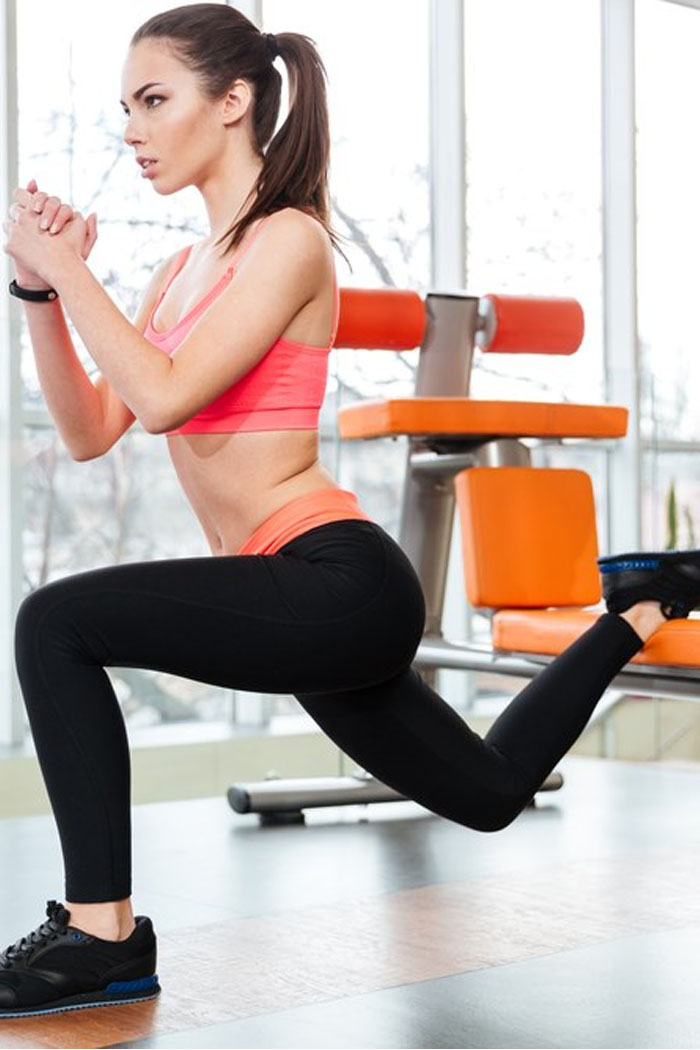That’s the beauty of circuit training: You can sweat through a total-body, strength-boosting and calorie-torching workout at turbo speed, without even leaving your own living room.
Not only is circuit training a super efficient way to work out, but it’s also pretty much guaranteed to be a good time. With endless ways to customize and mix up circuit training sessions and the quick pace at which you move, it really never gets old.
More good news: You don’t need to be a trainer to create at-home circuit-training workouts that are every bit as fun as they are effective—whether you’ve got 10 minutes to sweat or a full hour to get after it.
No matter what your individual workouts look like, circuit training consistently can help you burn fat, build muscle, and beat the boredom of same-old, same-old fitness routines.
Consider this your guide to all things circuit training—from the benefits of this workout style to how to plan your own sessions. If you want to jump right in, it’s also got 15-, 25-, and 45-minute pre-programmed circuit training workouts ready for you to crush.
What is circuit training?
Though people sometimes use the terms “circuit training” and “interval training” interchangeably, they’re not the same thing. On the contrary, “circuit training is a workout based around stations that you move through continuously, with little or no rest between them,” explains Ash Wilking, Nike trainer and Rumble instructor.
Basically, you’ll set up stations for different types of exercises, work at each for a set amount of time, and rotate from station to station quickly, keeping your heart rate up while challenging different parts of your body.
Here are a few key stations you’ll find in a good circuit training workout:
- Lower-body station (both legs)
- Upper-body station (arms)
- Lower-body station (single-leg)
- Core station
- Cardio station
Typically, you won’t need much of a break in between stations because each station (and exercise!) within the circuit targets a different muscle group or purpose, whether it’s strengthening your legs or challenging your cardio, says Wilking. That’s different than interval training, in which you alternate between high-intensity moves and low-intensity exercises or rest periods.

What are the benefits of circuit training?
The first benefit of circuit training is what Wilking calls the “anti-scrolling” effect it has on people. Basically, you won’t have a moment to get bored and hop on your phone (except to hit the start and stop timer). The result: You score a better, more complete workout.
Another perk is that you can do circuit training anywhere. Whether you’re in a gym or at home, you can circuit train with dumbbells or even just your bodyweight, says Wilking. Plus, because there are countless ways to customize your workout, it’s ideal for all fitness levels, too.
Oh, and did I mention how efficient it is? Circuit training allows you to work on both cardio and strength training simultaneously. It’s the perfect combo workout for torching body fat and building muscle at the same freaking time
In other words, circuit training burns calories quickly (around 200 to 300 in 30 minutes, according to Harvard Medical School), which is good news for anyone sweating with weight-loss goals in mind.
Finally, if you’re focused on improving your athletic performance, circuit training may help increase your VO2 max, or the amount of oxygen your body can consume at a given time, according to research published by the American College of Sports Medicine. It really is a fast-track to reaching your fitness goals!
How does circuit training work?
Circuit workouts typically consist of five to 10 stations, each of which corresponds to a muscle group or cardio. You can structure your session based on spending a specific amount of time at each stations, performing a specific number of reps at each station, or a mixture of both, Wilking says.
Of course the more time you have, the more rounds of your circuit you can move through (but even if you only have 15 minutes, you’ll still get a solid training session).
Since you’ll move from a station that targets, say, your upper body to one that fires up your legs, you can move quickly from station to station while still giving your muscle groups time to recover while others work, says Wilking. Your cardiovascular system, though? It keeps chugging away.
Whether you choose to add weights to your workout is totally up to you. Just know that if you do incorporate dumbbells or some other form of resistance, you likely won’t make it through as many reps at a given station—and that’s fine!
“You can likely do 25 body weight squats, for example, but maybe only 10 or 15 weighted squats,” Wilking says. Weights will add an extra challenge that ups the emphasis on building strength and muscle, while running through your circuit using light weights or just your bodyweight emphasizes cardio and muscle endurance.
Here’s how to warm up before circuit training.
Before launching into a circuit workout, spend at least five (and up to 15) minutes warming up, depending on how much time you have. A solid warm-up helps you avoid injury and preps your body to get to work, says trainer and AKT instructor Thomas Furdge, CPT.
Start with a general warm-up to get your blood flowing and boost your body temperature, suggests Peloton instructor Jess Sims. (Think jumping jacks and high knees.) Then, move onto a specific warm-up, which includes movements similar to those you’re about to do in your circuits. For example, if your training sesh involves goblet or weighted squats, do some slow bodyweight squats to get your bod ready to werk that exercise pattern in your actual workout.
Get started with one of these 3 circuit training workouts.
Ready to reap circuit training’s benefits but don’t quite want to go DIY just yet? Get after it at home using one of these workouts, created by Wilking.
15-Minute Circuit Training Workout
Instructions: Perform each move for 1 minute each, cycling through the circuit three times through without rest.
Lower body: Squats (bodyweight or weighted)
Upper body: Triceps dips
Single-beg: Reverse lunges
Core: Sit-ups
Cardio: 10 high knees + 3 burpees
25-Minute Circuit Training Workout
Instructions: Complete each move from Set A for 1 minute each. Then, rest for 1 minute and do the same with Set B. Repeat the two circuits once more through from the top, resting for 1 minute between them.
Set A (5 minutes)
Lower body: Sumo squats
Upper body: Plank walkouts or pushups
Single-leg: Lateral lunges
Abs: Flutter kicks
Cardio: Jump rope
Set B (5 minutes)
Lower body: Glute bridges
Upper body: Biceps curl to overhead presses
Single-leg: Alternating curtsy lunges
Abs: Deadbugs
Cardio: Side shuffles or Suicide sprints
45-Minute Circuit Training Workout
Instructions: Complete each move in order for 1 minute each. After you’ve finished all 10 moves, rest for 1 minute. Then, start from the top and repeat for four total rounds.
Lower body: Sumo squat
Upper body: Plank walkouts or pushups
Single-leg: Lateral lunges
Core: Flutter kicks
Cardio: Jump rope
Lower body: Glute bridges
Upper body: Biceps curl to overhead presses
Single-leg: Alternating curtsy lunges
Core: Deadbugs
Cardio: Lateral shuffle taps
And, finally, here’s how to cool down from your circuit workout.
Once you’re finished sweating, spend at least five minutes cooling down, says Sims, who recommends stretching each of your major muscles for at least 30 seconds. Stick to static (a.k.a. holding) stretching and try to relax into each stretch as much as possible without pushing to the point of pain.
The goal here: To help calm down your nervous system (decreasing your heart rate and blood pressure) while helping to keep your muscles long and your mobility on-point, says Furdge.







